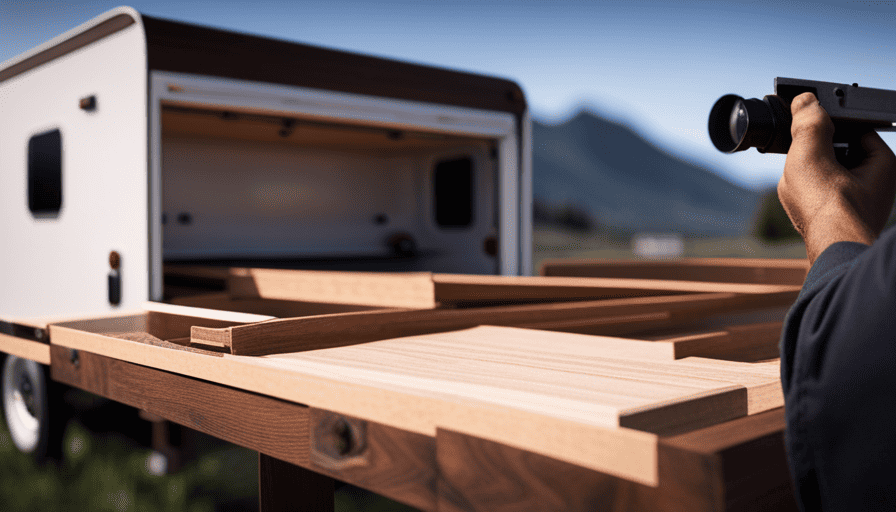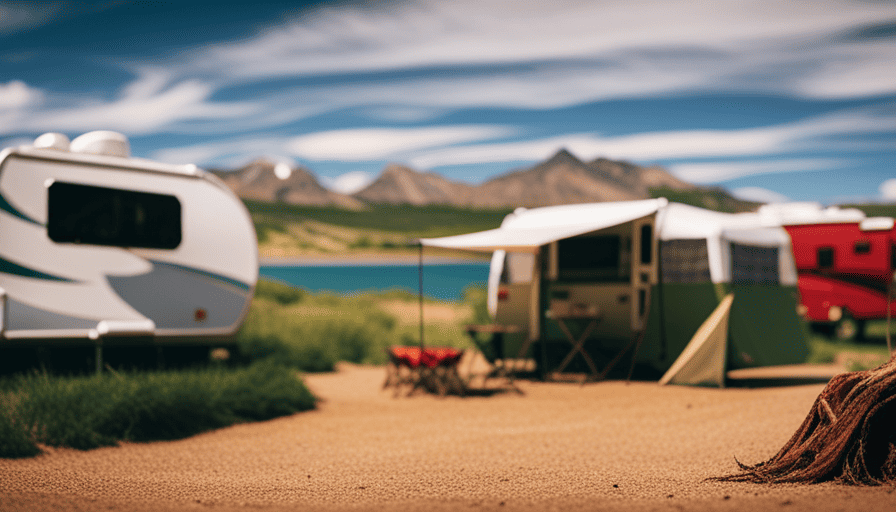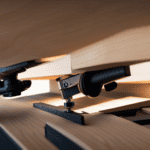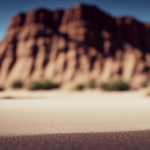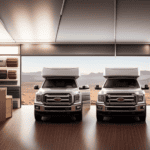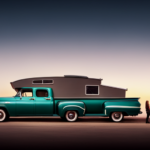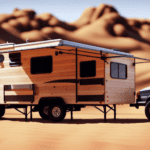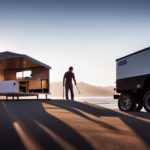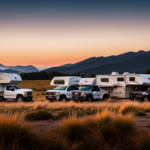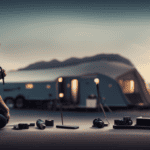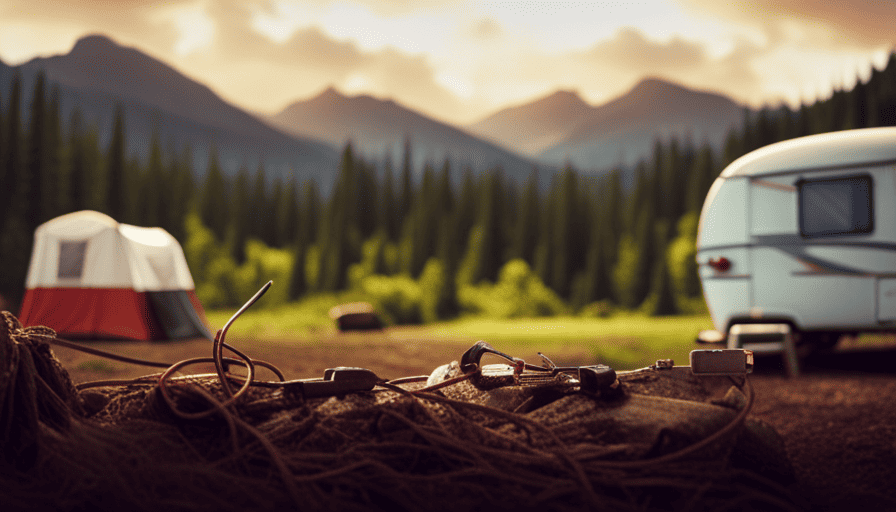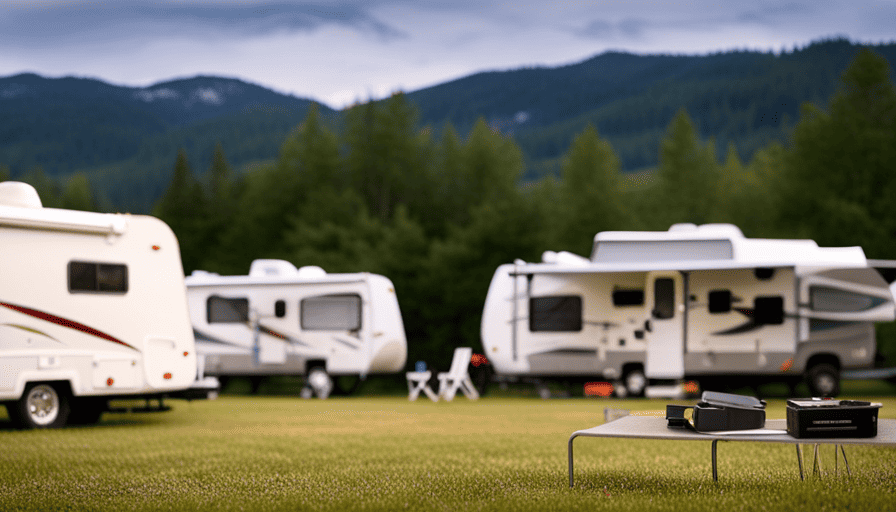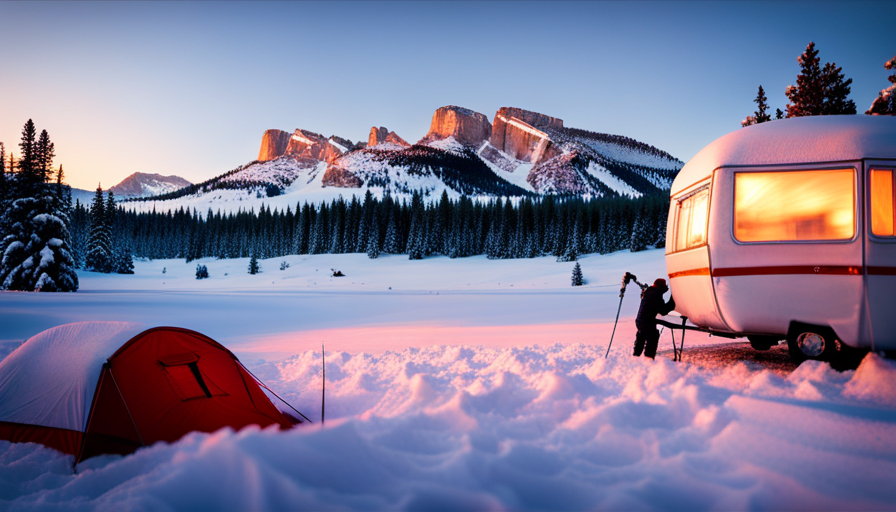Were you aware that a brand-new truck camper’s price can span between $10,000 and $50,000? That’s quite the sum for a mobile residence! However, what if I shared with you the possibility of constructing your own truck camper at a significantly lower expense?
In this article, I will guide you through the step-by-step process of building your own truck camper. From determining your needs and budget to customizing the interior and exterior, I will provide you with all the knowledge and information you need to create the camper of your dreams.
Whether you’re a seasoned DIY enthusiast or a beginner looking to embark on a new adventure, this article is for you. So grab your tools and let’s get started on building your very own truck camper! One of the great things about building your own truck camper is the opportunity to customize it to your specific needs and preferences. To help guide you through the process, be sure to check out our teardrop camper construction guide for step-by-step instructions and tips. With the right tools and a little bit of determination, you’ll soon be enjoying the open road in your own homemade camper.
Key Takeaways
- Determine your needs and budget before building a truck camper
- Research different types of campers and prioritize essential features
- Choose the right truck based on towing capacity and dimensions
- Plan and design the layout of the camper to optimize space utilization
Determine Your Needs and Budget
Before diving into the exciting world of truck camper building, it’s crucial to assess your needs and budget to ensure a custom-built camper that perfectly aligns with your adventurous spirit.
Determining your needs is the first step in this process. Research different types of campers and determine which features are essential for your lifestyle. Are you a solo traveler or do you have a family? Will you be camping in extreme weather conditions? These factors will help you prioritize the features you need in your camper.
Next, consider your budget. Building a truck camper can range from a few thousand dollars to tens of thousands, depending on the materials and features you choose. Set a realistic budget and stick to it. Research the cost of materials, appliances, and any additional customization you want.
By researching and prioritizing your needs and setting a budget, you will be able to make informed decisions throughout the camper building process. This will ensure that you create a camper that meets your specific requirements and stays within your financial means.
Now that you have determined your needs and budget, it’s time to choose the right truck for your camper.
Choose the Right Truck for Your Camper
Once you find the perfect steed, you’ll feel the thrill of embarking on an unforgettable adventure with your cozy home on wheels.
Choosing the right truck for your camper is crucial to ensure a smooth and safe journey. When considering the truck size, it is important to match it with the weight of your camper. The truck should have the necessary towing capacity to handle the weight without straining the engine or compromising on fuel efficiency.
To determine the right truck size, you need to know the weight of your camper. This includes not only the weight of the structure itself but also the weight of all the amenities and supplies you plan to carry. It is essential to choose a truck that can handle this weight comfortably, without exceeding its maximum towing capacity.
Additionally, you should consider the overall dimensions of the truck and camper combination. Make sure the truck is wide and long enough to accommodate the camper properly. You don’t want any overhang or imbalance that could affect stability while driving.
Once you have chosen the right truck for your camper, you can move on to the next step of planning and designing your camper layout. This will ensure that your camper meets all your needs and provides a comfortable living space during your travels.
Plan and Design Your Camper Layout
Designing the perfect layout for your cozy home on wheels is like creating a personalized oasis where you can relax and unwind during your unforgettable adventures. When it comes to camper layout design, optimizing space utilization is key.
Start by considering your needs and preferences. Think about how you’ll use each area of the camper and what features are essential for your comfort. Sketch out a rough floor plan, keeping in mind the dimensions of your truck and the available space.
Consider incorporating multi-functional furniture and storage solutions to make the most of limited space. Look for creative ways to maximize storage, such as utilizing vertical space and adding under-bed storage compartments. Remember to prioritize functionality and ease of movement throughout the camper.
Once you have a well-thought-out layout, gather the necessary materials and tools to bring your design to life. Incorporate sturdy materials and quality finishes for a durable and visually appealing camper interior.
Transitioning into the next section, gathering the necessary materials and tools is the next exciting step in turning your dream camper into a reality.
Gather the Necessary Materials and Tools
To gather all the materials and tools you need for your dream camper, start by creating a detailed checklist that includes everything from sturdy materials for construction to handy tools for the finishing touches.
Begin with the basics, such as plywood, insulation, screws, and nails. These will form the foundation of your camper and ensure its durability. Consider finding alternative materials as well, like reclaimed wood or recycled materials, to add a unique touch and reduce costs.
Next, gather the essential tools for the project. A circular saw, jigsaw, drill, and screwdriver are a must-have. These’ll help you cut and shape the materials, as well as assemble the camper. Don’t forget safety gear, such as gloves, goggles, and a dust mask, to protect yourself during the process.
Troubleshooting common challenges is also important. Anticipate potential issues, like water leaks or electrical problems, and be prepared with materials and tools to address them. Research and gather information on how to fix these issues efficiently.
With all the materials and tools in hand, you’re ready to move on to the next step: building the frame and structure of the camper.
Build the Frame and Structure of the Camper
Get ready to bring your dream camper to life by constructing a solid and sturdy frame that will be the backbone of your ultimate road-tripping adventure. The truck camper frame is the foundation on which the entire structure will rest, so it’s crucial to build it with precision and durability in mind.
Start by measuring and cutting the necessary steel or aluminum tubing according to the dimensions of your camper design. Weld the pieces together, ensuring that the joints are strong and secure. Reinforce the frame by adding cross braces and support beams at strategic points to distribute the weight evenly.
Once the truck camper frame is complete, it’s time to move on to building the structure of the camper. This involves attaching plywood or composite panels to the frame, creating the walls, roof, and floor of your camper. Use screws or nails to secure the panels in place, ensuring a tight fit and preventing any gaps that could compromise the integrity of the structure.
With the truck camper frame and structure in place, you’re now ready to install insulation for comfort and energy efficiency. By insulating the walls, roof, and floor, you can regulate the temperature inside the camper and reduce energy consumption.
Transitioning into the next section, let’s explore how to achieve optimal insulation for a cozy and efficient camper.
Install Insulation for Comfort and Energy Efficiency
After building the frame and structure of the camper, it’s time to focus on making it comfortable and energy efficient. This is where insulation comes into play. Insulation is essential for regulating temperature and reducing noise inside the camper. There are several types of insulation that you can choose from, such as fiberglass, foam, and reflective insulation. Each type has its own advantages and disadvantages, so it’s important to research and select the one that best suits your needs.
When it comes to installing insulation, there are a few techniques you can use. One common method is to measure and cut the insulation to fit the walls, floor, and ceiling of the camper. Then, you can secure it in place using adhesive or staples. Another technique is to use spray foam insulation, which expands to fill gaps and provides a seamless barrier against heat and cold.
To give you a better idea of the benefits of different insulation types and installation techniques, take a look at the table below:
| Insulation Type | Benefits |
|---|---|
| Fiberglass | Excellent thermal performance |
| Foam | Superior insulation and noise reduction |
| Reflective | Reflects heat away, keeping the camper cool |
Now that we have a well-insulated camper, it’s time to move on to the next step: building and installing furniture and storage units.
Build and Install Furniture and Storage Units
Now that insulation has created a cozy and efficient interior, it’s time to bring in the furniture and storage units to transform the camper into a functional and comfortable living space. Here are three key considerations for furniture design and storage organization:
-
Space Optimization: When it comes to furniture design in a truck camper, maximizing space is crucial. Opt for multi-functional pieces that can serve multiple purposes. For example, a sofa that can also be converted into a bed or a dining table with built-in storage compartments. Additionally, consider using foldable or collapsible furniture that can be easily stored away when not in use.
-
Storage Solutions: With limited space, effective storage organization is essential. Utilize every nook and cranny by incorporating storage units under beds, above cabinets, and even on the ceiling. Install shelves, hooks, and racks to keep items organized and easily accessible. Consider using modular storage systems that can be customized to fit your specific needs.
-
Lightweight Materials: Since a truck camper is subject to weight restrictions, opt for lightweight furniture materials such as aluminum or lightweight wood. This not only helps in reducing the overall weight of the camper but also makes it easier to move and rearrange furniture as needed.
With the furniture and storage units in place, the camper’s now ready to be transformed into a functional and comfortable living space. In the next section, we’ll discuss how to install electrical and plumbing systems to ensure a fully equipped camper experience.
Install Electrical and Plumbing Systems
Creating a fully equipped and functional living space requires the installation of electrical and plumbing systems, ensuring a comfortable and convenient camper experience. When it comes to electrical installation techniques, it’s important to start by planning the layout of your camper’s electrical system. This includes determining the locations of outlets, light fixtures, and any other electrical components you may want to include. It’s crucial to follow safety guidelines and consult a professional electrician if needed.
Additionally, be sure to choose the right wire size and properly ground all electrical connections.
As for plumbing system maintenance, it’s essential to start by installing a water storage tank or connecting to an external water source. This ensures a steady supply of fresh water for cooking, cleaning, and showering. To prevent leaks and ensure proper drainage, it’s crucial to install plumbing pipes and fittings correctly. Regularly check for any leaks or damaged pipes to avoid water damage and maintain the efficiency of your plumbing system.
Now that the electrical and plumbing systems are in place, it’s time to customize the interior and exterior of your camper. This allows you to add personal touches and make your camper truly feel like home.
Customize the Interior and Exterior of Your Camper
To truly make your camper feel like a cozy haven, let your imagination run wild and infuse your personal style into both the interior and exterior.
Customizing the interior of your truck camper is a fun and creative process that allows you to design a space that suits your needs and preferences. Start by selecting a color scheme that reflects your personality and creates a welcoming atmosphere. Consider adding curtains or blinds for privacy and to block out sunlight when needed. Install storage solutions such as shelves, cabinets, and hooks to keep your belongings organized and maximize space. Don’t forget to include comfortable seating and sleeping arrangements, as well as a functional kitchen area with appliances that suit your cooking style.
When it comes to the exterior design, there are many options to consider. Personalize your camper with decals or paint designs that showcase your individuality. Add awnings or a rooftop rack for extra storage and convenience. Consider installing outdoor lighting to create a cozy ambiance during evenings spent outdoors. Don’t forget about practical features such as a sturdy ladder for easy access to the roof or a bike rack for your adventurous outings.
Customizing the interior and exterior of your camper allows you to create a space that reflects your personal taste and enhances your overall camping experience. Once you’ve completed these customization steps, it’s time to hit the road and test out your DIY truck camper in the great outdoors!
Test and Enjoy Your DIY Truck Camper on the Open Road!
Hit the open road and revel in the freedom of traveling in your very own DIY truck camper, as you embark on unforgettable adventures and make memories that will last a lifetime.
Now that your truck camper is complete and customized to your liking, it’s time to ensure its proper maintenance and find the best camping spots for your travels.
Truck camper maintenance is crucial to keep your home on wheels in top shape. Regularly check the tire pressure, brakes, and engine fluids to ensure a safe and smooth journey. Inspect the camper’s exterior for any signs of damage or leaks, and promptly address any issues to prevent further problems down the road. Keep the interior clean and organized, as a tidy space will make your camping experience more enjoyable.
When it comes to finding camping spots, there are numerous options to choose from. Research national parks, state parks, and campgrounds in the areas you wish to visit. Look for sites that offer the amenities you desire, such as water and electricity hookups, showers, and picnic areas. Consider the activities available nearby, such as hiking trails, fishing spots, or scenic viewpoints.
Remember to plan your trips in advance, especially during peak seasons, as popular camping spots can fill up quickly. Embrace the freedom of the open road and embark on your DIY truck camper adventures with confidence, knowing that you have taken the necessary steps to maintain your camper and find the perfect camping spots for your travels.
Happy camping!
Frequently Asked Questions
How much weight can my truck safely carry with a camper installed?
How much weight can my truck safely carry with a camper installed?
To determine the weight capacity of your truck, you need to consider the truck camper weight limits specified by the manufacturer. These limits are based on factors such as the truck’s suspension, tires, and braking system.
It’s crucial to calculate the weight of the camper, including the gear and supplies, and ensure it doesn’t exceed the truck’s payload capacity. This ensures safe and efficient operation of your vehicle.
What is the average cost of building a truck camper?
The average cost of building a truck camper can vary depending on the materials needed. Generally, you can expect to spend anywhere from $3,000 to $15,000.
The cost will largely depend on the type of materials you choose, such as wood or aluminum, and the size and features you want for your camper. It’s important to budget for things like insulation, windows, appliances, and furnishings, as these will also impact the overall cost.
Can I legally park and camp in a truck camper in residential areas?
In many residential areas, there are parking restrictions that may impact your ability to park and camp in a truck camper. It’s important to check the local regulations to ensure compliance.
Additionally, noise regulations may also apply, so it’s essential to be mindful of your surroundings and keep noise levels to a minimum.
By being aware of these restrictions and regulations, you can enjoy a peaceful and legal camping experience in your truck camper.
How do I ensure my camper is properly sealed to prevent leaks?
To ensure my camper is properly sealed and prevent leaks, I employ proper sealing techniques. Some common causes of camper leaks include gaps around windows, doors, and vents, as well as deteriorated sealant.
I ensure a watertight seal by using high-quality silicone sealant or butyl tape on all seams and openings. Regularly inspecting and resealing these areas will help maintain the integrity of my camper and keep it leak-free.
Are there any specific safety regulations or guidelines I need to follow when building a truck camper?
When it comes to building a truck camper, it’s crucial to prioritize safety regulations and follow proper building techniques. These guidelines ensure that your camper is structurally sound and secure for your travels. From electrical wiring to propane systems, every aspect must meet safety standards.
Remember, ‘safety first’ is not just a cliché, it’s a golden rule that should guide your entire construction process. So, make sure to thoroughly research and adhere to all safety regulations before diving into your camper build.
Is Building a Truck Bed Camper Similar to Building a Truck Camper?
Building a truck bed camper involves constructing a lightweight camper that sits directly on the truck bed. While similar in concept to building a truck camper, the key difference lies in the location of the camper. A truck bed camper construction guide provides step-by-step instructions on building a camper specifically designed for the truck bed, ensuring proper weight distribution and stability.
Conclusion
In conclusion, building a truck camper is a rewarding and fulfilling project that allows you to create a personalized space for your adventures on the road. By following the steps outlined in this article, you can create a camper that suits your needs and budget.
Remember, attention to detail and careful planning are key in ensuring a successful build. So, why wait? Get started on your DIY truck camper and embark on a journey filled with freedom and endless possibilities. Happy camping!

